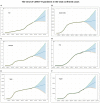Data-Driven and Machine-Learning Methods to Project Coronavirus Disease 2019 Pandemic Trend in Eastern Mediterranean
- PMID: 34055708
- PMCID: PMC8158576
- DOI: 10.3389/fpubh.2021.602353
Data-Driven and Machine-Learning Methods to Project Coronavirus Disease 2019 Pandemic Trend in Eastern Mediterranean
Abstract
Background: The coronavirus disease 2019 (COVID-19) pandemic has become a major public health crisis worldwide, and the Eastern Mediterranean is one of the most affected areas. Materials and Methods: We use a data-driven approach to assess the characteristics, situation, prevalence, and current intervention actions of the COVID-19 pandemic. We establish a spatial model of the spread of the COVID-19 pandemic to project the trend and time distribution of the total confirmed cases and growth rate of daily confirmed cases based on the current intervention actions. Results: The results show that the number of daily confirmed cases, number of active cases, or growth rate of daily confirmed cases of COVID-19 are exhibiting a significant downward trend in Qatar, Egypt, Pakistan, and Saudi Arabia under the current interventions, although the total number of confirmed cases and deaths is still increasing. However, it is predicted that the number of total confirmed cases and active cases in Iran and Iraq may continue to increase. Conclusion: The COVID-19 pandemic in Qatar, Egypt, Pakistan, and Saudi Arabia will be largely contained if interventions are maintained or tightened. The future is not optimistic, and the intervention response must be further strengthened in Iran and Iraq. The aim of this study is to contribute to the prevention and control of the COVID-19 pandemic.
Keywords: COVID-19; assessment; data-driven; machine learning; projection.
Copyright © 2021 Huang, Ao, Han, Liu, Liu and Huang.
Conflict of interest statement
The authors declare that the research was conducted in the absence of any commercial or financial relationships that could be construed as a potential conflict of interest.
Figures





Similar articles
-
SARS-CoV-2 Surveillance in the Middle East and North Africa: Longitudinal Trend Analysis.J Med Internet Res. 2021 Jan 15;23(1):e25830. doi: 10.2196/25830. J Med Internet Res. 2021. PMID: 33302252 Free PMC article.
-
COVID-19 Trends and Forecast in the Eastern Mediterranean Region With a Particular Focus on Pakistan.Cureus. 2020 Jun 12;12(6):e8582. doi: 10.7759/cureus.8582. Cureus. 2020. PMID: 32670717 Free PMC article.
-
Forecasting the spread of the COVID-19 pandemic in Saudi Arabia using ARIMA prediction model under current public health interventions.J Infect Public Health. 2020 Jul;13(7):914-919. doi: 10.1016/j.jiph.2020.06.001. Epub 2020 Jun 8. J Infect Public Health. 2020. PMID: 32546438 Free PMC article.
-
Contribution of Saudi Arabia to regional and global publications on COVID-19-related research: A bibliometric and visualization analysis.J Infect Public Health. 2022 Jul;15(7):709-719. doi: 10.1016/j.jiph.2022.05.013. Epub 2022 May 27. J Infect Public Health. 2022. PMID: 35667303 Free PMC article. Review.
-
Preparedness and response to COVID-19 in Saudi Arabia: Building on MERS experience.J Infect Public Health. 2020 Jun;13(6):834-838. doi: 10.1016/j.jiph.2020.04.016. Epub 2020 May 11. J Infect Public Health. 2020. PMID: 32451260 Free PMC article. Review.
Cited by
-
Simulation and forecasting models of COVID-19 taking into account spatio-temporal dynamic characteristics: A review.Front Public Health. 2022 Oct 18;10:1033432. doi: 10.3389/fpubh.2022.1033432. eCollection 2022. Front Public Health. 2022. PMID: 36330112 Free PMC article. Review.
-
Dynamics of an epidemic controlled by isolation and quarantine: A probability-based deterministic model.Infect Dis Model. 2025 Mar 18;10(3):813-839. doi: 10.1016/j.idm.2025.03.007. eCollection 2025 Sep. Infect Dis Model. 2025. PMID: 40271143 Free PMC article.
-
A Systematic Review of the Outcomes of Utilization of Artificial Intelligence Within the Healthcare Systems of the Middle East: A Thematic Analysis of Findings.Health Sci Rep. 2024 Dec 24;7(12):e70300. doi: 10.1002/hsr2.70300. eCollection 2024 Dec. Health Sci Rep. 2024. PMID: 39720235 Free PMC article. Review.
References
-
- WHO . WHO Director-General's Opening Remarks at the Mission Briefing on COVID-19 (2020). Available online at: https://www.who.int/dg/speeches/detail/who-director-general-s-opening-re... (accessed March 12, 2020).
-
- WHO . Coronavirus Disease (COVID-19) Weekly Epidemiological Update 2 (2020). Available online at: https://www.who.int/docs/default-source/coronaviruse/situation-reports/2... (accessed August 26, 2020).
-
- JHU . COVID-19 Map - Johns Hopkins Coronavirus Resource Center (2020). Available online at: https://coronavirus.jhu.edu/map.html (accessed August 26, 2020).
-
- ACAPS . ACAPS COVID-19 Government Measures Dataset Geneva: (ACAPS) (2020).
Publication types
MeSH terms
LinkOut - more resources
Full Text Sources
Other Literature Sources
Medical

